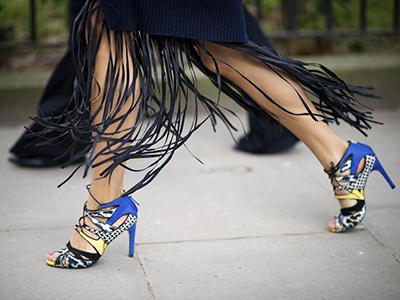Why a Medicure Will Change your life (or at least your feet)

There’s a moment during every pedicure when I lean back, close my eyes, and make peace with the fact that this is the time I’m definitely going to contract antibiotic-resistant MRSA. Years of warning readers about the possible dangers—unsterilized metal tools or hidden fungus and bacteria multiplying in whirlpool baths—have truly sucked the joy out. But there’s no ignoring the screaming feet of a consummate New Yorker (read: someone who doesn’t own a car), so when I heard about medi-pedis I got nerdily excited. Hey, medicures sound hygienic!
I visited toe whisperer Marcela Correa at NYC Medical Pedicure in midtown. With its stark white walls and fluorescent lights, it felt more like a doctor’s office than a salon. (Makes sense, since she grew up in Uruguay assisting her podiatrist father at work. "He was my hero," she says. "I went to cosmetology school because he said to study a different subject, just in case. But I love feet.") No one offered me a glass of sparkling water or champagne. Or a massage. I was led into a smaller office with a pedicure chair, where I immediately flung off my shoes and socks and frantically started cleaning fluff out from between my toes out of embarrassment. Correa is an outspoken critic of wet pedicures, so there was no foot bath to wash away my sock-related shame. Unfazed, she wielded her antiseptic spray. "Water spreads bacteria," she says. "If you have a nail infection, it [can] spread to the other foot when you soak."
FYI, not just anybody can offer a medical pedicure. Licensed medical nail technicians have taken advanced training courses, in which they learn to safely remove dead, damaged, or infected tissue, reduce calluses, and work with special-needs patients, like diabetics and the elderly. For the next hour or so, I submitted to Correa and her assistant.
She used a variety of sterile tools that looked like they belonged to a dentist and an electric buffer as she schooled me on foot facts. Three things I learned about the average woman: Your toenails are too long; even one millimeter over the edge of the toe will bang against the toebox of your shoe. You should legit scrub your feet in the shower, or else shampoo, conditioner, soap, body wash, and layers of nail-polish residue can build up. And you never remember to put SPF on. As the only part of the body that doesn’t cast a shadow, feet in particular need protection. "Last year I saw 13 melanomas," Correa says.
At $120, the treatment is relatively spendy for a pedicure. However, it was so transformative that when it was over I didn’t even need a coat of clear nail polish. My pale, corpselike toenails actually had a healthy glow I see only on children. The skin of my feet felt supple and smooth. Not a dry spot or callus in sight. She buffed just enough skin off the soles—when a manicurist files skin too thin, the sensitive area can be prone to blisters. I felt like there was suddenly more room in my shoes. It sounds crazy, but I was pretty convinced she somehow replaced my feet with new, better ones. And look who doesn’t have MRSA? This girl!
I’m already back to nail polish (I was feeling too much like a hippie), but I’m planning on visiting Correa for a medi-pedi once or twice a year. It’s basically a pedestrian’s version of car maintenance.
More: Medicure Experience

